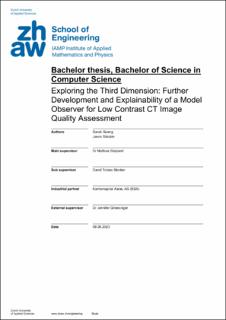Please use this identifier to cite or link to this item:
https://doi.org/10.21256/zhaw-29945| Publication type: | Bachelor thesis |
| Title: | Exploring the third dimension : further development and explainability of a model observer for low contrast CT image quality assessment |
| Authors: | Gueng, Sarah Stäuble, Jason |
| Advisors / Reviewers: | Weyland, Mathias Stocker, David Tobias Griessinger, Jennifer |
| DOI: | 10.21256/zhaw-29945 |
| Extent: | 48 |
| Issue Date: | 2023 |
| Series: | Bachelorarbeiten ZHAW School of Engineering |
| Publisher / Ed. Institution: | ZHAW Zürcher Hochschule für Angewandte Wissenschaften |
| Publisher / Ed. Institution: | Winterthur |
| Language: | English |
| Subject (DDC): | 006: Special computer methods |
| Abstract: | During Computed Tomography (CT) imaging, patients are being exposed to ionising radiation, which causes cell damage and increases the risk of developing cancer. As a higher radiation dosage generally leads to a better image quality, the co-optimisation of dosage and image quality must be achieved. To perform a low-contrast CT image quality assessment, the novel Difference Detail Curve (DDC) method, where the minimal contrast needed to perceive a contrast object is related to its size, can be used. This work further developed a model observer based on the U-Net architecture which aims to reduce the human annotation effort involved in the DDC method. Furthermore, eXplainable AI (XAI) methods were applied to gain insights about the decision-making process of the model. As the predecessor model only used one of the cross-sectional slices of the CT scan, the influence of using the entire slice stack was explored, since it is being utilised by human observers as well. In other words, information from the third dimension available from the slice stack is also taken into account for the DDC method. In order to achieve this, three models were trained with different compositions of an existing dataset consisting of scans of a phantom containing cylindrical contrast objects of different sizes, ranging from 3 mm to 9 mm. The contrast objects are surrounded by epoxy resin and feature five different contrast values, which are given in Hounsfield Units (HU) in relation to the surrounding epoxy material (16 ΔHU, 32 ΔHU, 48 ΔHU, 64 ΔHU and 80 ΔHU). The scans were annotated by ten different human observers. The models were trained with those scans and corresponding human annotations in order to be able to mimic the annotation behaviour. The following three models were tested with these data: (1) a baseline model taking only one slice of the slice stack as input, (2) the same model, but fed with a mean of all slices along the longitudinal axis of the scan, (3) a full 3D model using the entire slice stack. After training the models, they were evaluated using different performance metrics, e.g. Intersection over Union (IoU). The baseline model (1) achieved an IoU of 0.78, the model using the mean of the slices (2) achieved an IoU of 0.84 and the 3D model (3) achieved an IoU of 0.83. All three models were found to mimic the human annotation behaviour rather well. Nevertheless, models (2) and (3) performed slightly better than model (1), suggesting that the usage of information from the third dimension may be relevant to closely mimic the human observers. Model (3) did not outperform model (2), which indicates that the mean of the slices already contains the most valuable information. However, this finding is limited to cylindrically shaped low-contrast objects. Therefore, the 3D model (3) might be more suitable for different low-contrast object structures (e.g. spheres) in the future. As the predecessor models focused on irrelevant prominent structures in the scan, such as airgaps from which the orientation of the contrast objects could be derived, the dataset was additionally preprocessed to remove those. The XAI results provided supporting evidence that the evaluated models successfully focus on the relevant structures. |
| URI: | https://digitalcollection.zhaw.ch/handle/11475/29945 |
| License (according to publishing contract): | CC BY 4.0: Attribution 4.0 International |
| Departement: | School of Engineering |
| Appears in collections: | Bachelorarbeiten ZHAW School of Engineering |
Files in This Item:
| File | Description | Size | Format | |
|---|---|---|---|---|
| 2023_Gueng-Sarah_Staeuble-Jason_BA_SoE.pdf | 8.79 MB | Adobe PDF |  View/Open |
Show full item record
Gueng, S., & Stäuble, J. (2023). Exploring the third dimension : further development and explainability of a model observer for low contrast CT image quality assessment [Bachelor’s thesis, ZHAW Zürcher Hochschule für Angewandte Wissenschaften]. https://doi.org/10.21256/zhaw-29945
Gueng, S. and Stäuble, J. (2023) Exploring the third dimension : further development and explainability of a model observer for low contrast CT image quality assessment. Bachelor’s thesis. ZHAW Zürcher Hochschule für Angewandte Wissenschaften. Available at: https://doi.org/10.21256/zhaw-29945.
S. Gueng and J. Stäuble, “Exploring the third dimension : further development and explainability of a model observer for low contrast CT image quality assessment,” Bachelor’s thesis, ZHAW Zürcher Hochschule für Angewandte Wissenschaften, Winterthur, 2023. doi: 10.21256/zhaw-29945.
GUENG, Sarah und Jason STÄUBLE, 2023. Exploring the third dimension : further development and explainability of a model observer for low contrast CT image quality assessment. Bachelor’s thesis. Winterthur: ZHAW Zürcher Hochschule für Angewandte Wissenschaften
Gueng, Sarah, and Jason Stäuble. 2023. “Exploring the Third Dimension : Further Development and Explainability of a Model Observer for Low Contrast CT Image Quality Assessment.” Bachelor’s thesis, Winterthur: ZHAW Zürcher Hochschule für Angewandte Wissenschaften. https://doi.org/10.21256/zhaw-29945.
Gueng, Sarah, and Jason Stäuble. Exploring the Third Dimension : Further Development and Explainability of a Model Observer for Low Contrast CT Image Quality Assessment. ZHAW Zürcher Hochschule für Angewandte Wissenschaften, 2023, https://doi.org/10.21256/zhaw-29945.
Items in DSpace are protected by copyright, with all rights reserved, unless otherwise indicated.